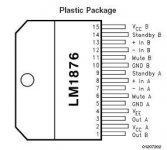Hey everybody
I was thinking about building a simple guitaramp, using a fuzz effect (http://www.runoffgroove.com/multiface.html that one) as a preamp. My question is, will this effect generate enough output to drive a gainclone (http://www.decdun.fsnet.co.uk/gainclone.html) ?
Another question. The chip suggested isn't available from the source i get my parts from. They do however stock the LM1876TF. Would I have to make any changes to accomodate for this chip? (and if so, which? I couldn't really figure it out myself).
I hope you can answer my questions.
I was thinking about building a simple guitaramp, using a fuzz effect (http://www.runoffgroove.com/multiface.html that one) as a preamp. My question is, will this effect generate enough output to drive a gainclone (http://www.decdun.fsnet.co.uk/gainclone.html) ?
Another question. The chip suggested isn't available from the source i get my parts from. They do however stock the LM1876TF. Would I have to make any changes to accomodate for this chip? (and if so, which? I couldn't really figure it out myself).
I hope you can answer my questions.
zeegeit said:My question is, will this effect generate enough output to drive a gainclone?
Yes.
zeegeit said:They do however stock the LM1876TF. Would I have to make any changes to accomodate for this chip? (and if so, which? I couldn't really figure it out myself).
The datasheet for this chip is here:
http://cache.national.com/ds/LM/LM1876.pdf
The LM1876 is 2 by 20W, you could make 2 channels, or bridge 2 channels if your speaker is 8 ohms, or even just ignore the 2nd channel if you have no use for it.
This is the pinout from that datasheet:
Attachments
allright then..I understand. Thanks 😀 I found an informative website where someone has published the resistor and capacitator values for a gainclone with a LM1875 as well, here it is http://www.platenspeler.com/gainclone.html
So that should be quite easy to figure out..maybe I can order some samples from National (do they charge you with any shipping? ) . But anyways, I think I can figure out the things I need for the amp itself.
Next problem : the PSU. I'm a bit confused about the transformer I should use(the only thing I do know, is that it's probably going to be the most expensive part of the entire amp). Some people say you should have at least 80 VAC , others say at least 160. Is there a formula to calculate this, so for instance if I would want to make an amp with an output power of , say 20 watts(based on a LM1875) @ 8 ohm , what kind of transformer would I have to use?
So that should be quite easy to figure out..maybe I can order some samples from National (do they charge you with any shipping? ) . But anyways, I think I can figure out the things I need for the amp itself.
Next problem : the PSU. I'm a bit confused about the transformer I should use(the only thing I do know, is that it's probably going to be the most expensive part of the entire amp). Some people say you should have at least 80 VAC , others say at least 160. Is there a formula to calculate this, so for instance if I would want to make an amp with an output power of , say 20 watts(based on a LM1875) @ 8 ohm , what kind of transformer would I have to use?
zeegeit said:Next problem : the PSU. I'm a bit confused about the transformer I should use(the only thing I do know, is that it's probably going to be the most expensive part of the entire amp). Some people say you should have at least 80 VAC , others say at least 160. Is there a formula to calculate this, so for instance if I would want to make an amp with an output power of , say 20 watts(based on a LM1875) @ 8 ohm , what kind of transformer would I have to use?
If you want to figure out the minimum transformer you need to buy, then read the datasheet, it walks you through the design process.
I would advise you that if you are *buying* a transformer, not recycling one or buying an outstanding deal or surplus, to buy something 150-160 VA per chip. I just see so many people skimping like that and I think "what is the point?"
- Status
- Not open for further replies.
